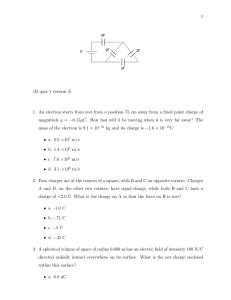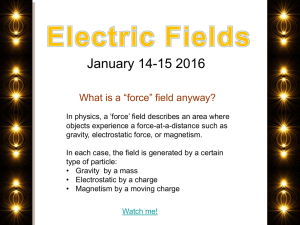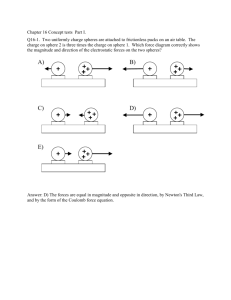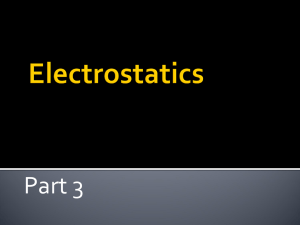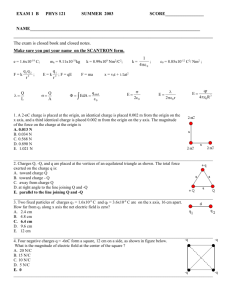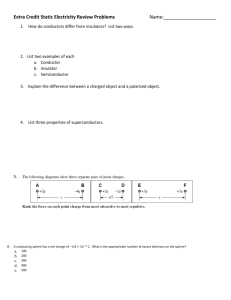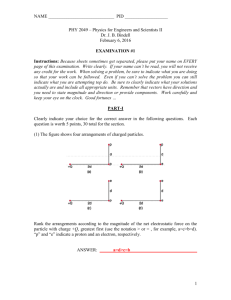AP Physics 1: Electric Force & Field Test
advertisement
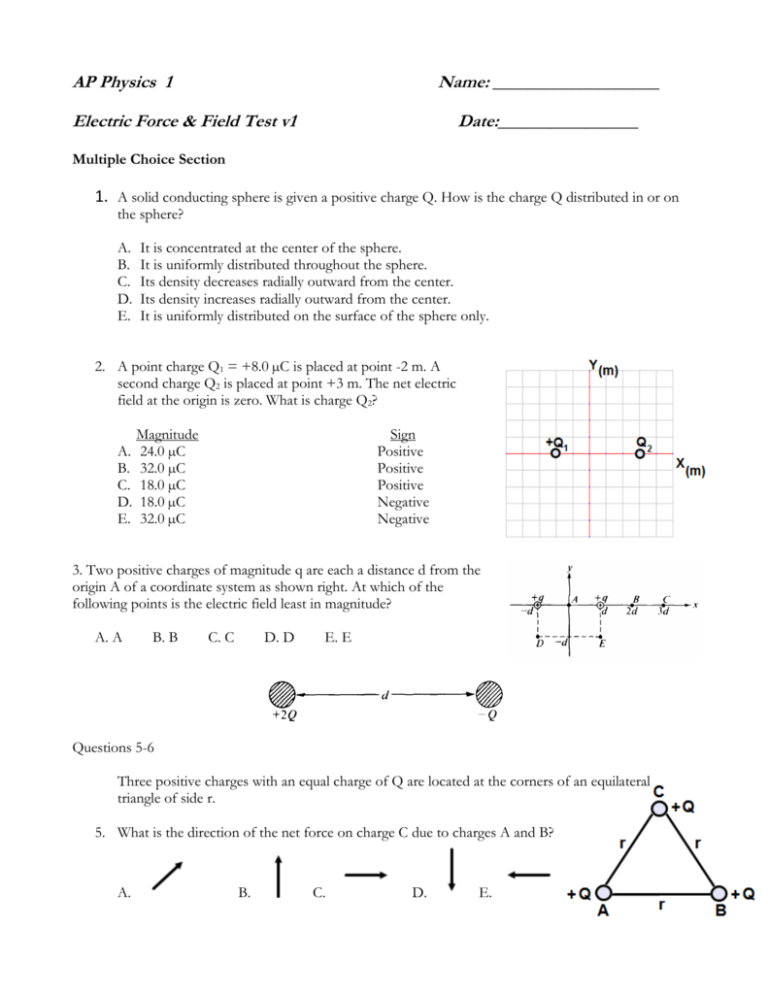
AP Physics 1 Name: ___________________ Electric Force & Field Test v1 Date:________________ Multiple Choice Section 1. A solid conducting sphere is given a positive charge Q. How is the charge Q distributed in or on the sphere? A. B. C. D. E. It is concentrated at the center of the sphere. It is uniformly distributed throughout the sphere. Its density decreases radially outward from the center. Its density increases radially outward from the center. It is uniformly distributed on the surface of the sphere only. 2. A point charge Q1 = +8.0 µC is placed at point -2 m. A second charge Q2 is placed at point +3 m. The net electric field at the origin is zero. What is charge Q2? A. B. C. D. E. Magnitude 24.0 µC 32.0 µC 18.0 µC 18.0 µC 32.0 µC Sign Positive Positive Positive Negative Negative 3. Two positive charges of magnitude q are each a distance d from the origin A of a coordinate system as shown right. At which of the following points is the electric field least in magnitude? A. A B. B C. C D. D E. E Questions 5-6 Three positive charges with an equal charge of Q are located at the corners of an equilateral triangle of side r. 5. What is the direction of the net force on charge C due to charges A and B? A. B. C. D. E. 6. What is the magnitude of the net force on charge C due to two charges A and B? 𝑄2 𝑄2 A. √3 𝑘 𝑟 2 B. 3k 𝑟 2 𝑄2 C. 2k 𝑟 2 𝑄2 D. √2 k 𝑟 2 𝑄2 E. k 𝑟 2 7. A hollow metal sphere of radius R is positively charged. Of the following distances from the center of the sphere, which location will have the greatest electric field strength? A. 0 (center of the sphere) B. 3R/2 C. 5R/4 D. 2R E. None of the above because the field is of constant strength 8. Two isolated charges, + q and - 2q, are 2 centimeters apart. If F is the magnitude of the force acting on charge -2Q, what are the magnitude and direction of the force acting on charge + q? A. B. C. D. E. 9. Magnitude (1/2) F 2F F F 2F Direction Toward charge - 2q Away from charge -2q Toward charge - 2q Away from charge - 2q Toward charge - 2q Which of the following graphs best represents the force as a function of distance between two point charge q1 and q 2 as they are moved further apart? (A) I (B) II (C) III (D) IV Multi-Correct: Students will need to select all the correct answers to the question below in order to earn credit. 9. Which of the following is possible electric interaction between two charges? (A) (B) (C) AP Physics 1 (D) Name: ___________________ Electric Force & Field Test v1 Date:________________ Free Response Section Two positive charges with a magnitude of 8 µC are placed at the opposite corners of a square 2 m on a side. a. Find the electrical force on b. On the diagram above, draw and label these two forces. each of the two positive charges. Two small objects, labeled 1 and 2 in the diagram above, are suspended in equilibrium from strings of length L. Each object has mass m and charge +Q. Assume that the strings have negligible mass and are insulating and electrically neutral. Express all algebraic answers in terms of m, L, Q, q , and fundamental constants. a. On the following diagram, sketch lines to illustrate a 2-dimensional view of the net electric field due to the two objects. b. Deriver an expression for the electric force between the objects. Two charges, Q1 = +1.8μC and Q2 = -2.2μC, are located at the coordinate system as shown above. a. Find the magnitude of the force between the charges. State whether this force is attractive or repulsive. b. Find the magnitude and direction of the electric field due to charge Q1 at the origin. c. Find the magnitude and direction of the electric field due to charge Q2 at the origin. d. Find the magnitude and direction (the angle it makes with the x-axis) of the net electric field at the origin. Multiple Choice Answers (12 points) 1. 2. 3. 4. E C A B 5. 6. 7. 8. Free Response Answers (15 points) A C C C 9. D 10. C, D 11. 13. 12. 14. 13. a. 𝐹1 = 𝐹2 = 𝑘 𝑞1 𝑞2 𝑟2 = (9 × 𝑁𝑚2 (8×10−6 𝐶) 109 𝐶 2 ) 2 (2√2𝑚) 2 = 𝟎. 𝟎𝟕𝟐𝑵 2 points b. 2 points a. 2 points b. 𝑘𝑞1 𝑞2 𝐹𝐸 = 𝑟2 𝑘𝑄 2 = (2𝐿 3 points sin 𝜃)2 Free Response Answers (15 points) a. (4 points) 𝑟 = √3𝑚2 + 4𝑚2 = 5𝑚 𝐹= 𝑘𝑄1 𝑄2 = 𝑟2 (9 × 109 𝑁𝑚2 ) (1.8 × 10−6 𝐶)(2.2 × 10−6 𝐶) 𝐶2 = 𝟎. 𝟎𝟎𝟏𝟒𝑵 𝒐𝒓 𝟏. 𝟒 × 𝟏𝟎−𝟑 𝑵 5𝑚2 The force is attractive. b. (3 points) 𝐸= 𝑘𝑄1 𝑟2 = (9×109 𝑁𝑚2 )(1.8×10−6 𝐶) 𝐶2 4𝑚2 = 𝟏𝟎𝟏𝟑 c. (3 points) 𝐸= 𝑘𝑄1 𝑟2 𝑵 𝟐𝟐𝟎𝟎 𝑪 = (9×109 𝑁𝑚2 )(2.2×10−6 𝐶) 𝐶2 3𝑚2 = The direction is right. 𝑵 𝑪 The direction is down. d. (5 points) 𝑁 2 𝑁 2 𝑵 𝐸𝑛𝑒𝑡 = √(1013 ) + (2200 ) = 𝟐𝟒𝟐𝟐 𝐶 𝐶 𝑪 𝜃 = tan −1 𝑁 1013 𝐶 ( ) = 𝟐𝟒. 𝟕° 𝑁 2200 𝐶
